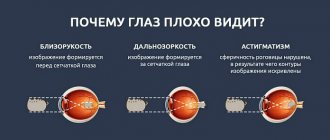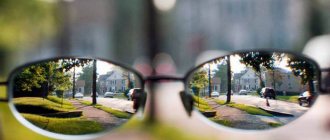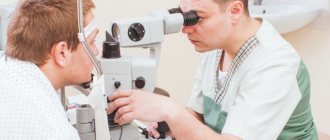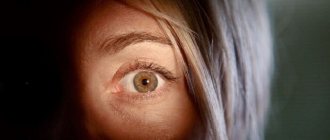Why are people admitted to school from the age of 7?
Parents often wonder why their child is enrolled in school from the age of seven. This is due to the fact that by this time the baby is already beginning to form abstract thinking, without which it is impossible to learn the rules of grammar or arithmetic. Also, the refraction of the eye becomes emmetropic by the age of seven. This means that the child will be equally comfortable reading from the board or in a book. There is also the development of fine motor skills and the muscles of the fingers, which become ready for writing.
In connection with possible visual impairment, parents and teachers should pay special attention to indirect signs that appear in changes in refraction. These include the following:
1. The child sits very close to the screen or brings the book to his very nose when reading. 2. The baby runs his finger along the line he is reading or completely loses the place of reading. 3. Squints when looking or tilts head to improve vision. 4. May close one eye while watching TV or reading. 5. The child does not engage in sports that require good vision at a distance, or avoids reading and drawing, since this requires clear vision up close. 6. The baby closes his eyes from bright lighting or often rubs his eyes. 7. Experiences a headache due to overexertion or complains of eye fatigue. 8. Does not use a computer in everyday life. 9. I began to study worse than before.
AGE-AGED farsightedness
After forty years, most of us experience deterioration in near vision or age-related farsightedness (presbyopia) . This is more likely not a disease, but a condition of the eyes, when with age the elasticity of the lens weakens and the ciliary muscle can no longer change its shape. As a result, the ability to distinguish small objects at a distance of 20–30 cm is lost. The first signs of presbyopia are deterioration in near visual acuity (which manifests itself in a person’s desire to move text further away from him when reading), decreased visual performance, and rapid fatigue. In the future, there may be redness of the eyes, unpleasant sensations (even stinging, pain) in the eyes that occur with significant visual load, and photophobia may appear. Usually, distance visual acuity remains high, but if you do not put on glasses in time, then due to eye fatigue, distance vision will also deteriorate; there may be prerequisites for the development of eye diseases: conjunctivitis, blepharitis and others.
Next: Why vision control is important
Screening examination by an ophthalmologist
Traditionally, screening examinations by an ophthalmologist are performed in the third, ninth and eleventh grades. During these examinations, doctors identify children who are at increased risk of developing the most common eye problems.
It should be noted that screening itself cannot replace a full examination by an ophthalmologist. In this regard, in addition to traditional screening studies, you should visit an ophthalmologist with your child at least once every two years. If the baby already has vision problems and wears contact lenses or glasses, then the doctor should be visited once a year. Due to the fact that as the child grows, the size of his eyes changes, at this age glasses or lenses for good vision are changed quite often.
Eye diseases in schoolchildren
Among the most common eye diseases in school-age children are:
- Myopia, which is associated with an increase in the size of the eyeball or develops due to the increased refractive ability of the transparent media of the eye. As a result, the image is focused not on the retinal plane itself, but in front of it. The image on the retina becomes blurry and unclear. The most typical age for the development of myopia is 8-14 years. This is due to the active growth of the eye during this period, as well as an increased load on the apparatus responsible for accommodation. With myopia, it is difficult for a child to look at distant objects, in particular at the blackboard in the classroom. To correct myopia, lenses with negative diopters (divergent) are used.
- Hypermetropia occurs as a result of a decrease in the size of the eyeball or insufficient refractive power of the optical media of the eye. In this case, a clear image is formed behind the plane of the retina, while on the retina itself the image is blurred. Farsightedness is most often diagnosed in children under ten years of age. With a low degree of refractive error, the child has excellent distance vision. At the same time, he also sees well close up due to active accommodation. If the severity of hypermetropia is more than 3.5 diopters, then the doctor recommends the use of glasses. They should also be used when the refractive power of the two eyes is different, or when symptoms of overstrain appear (eye fatigue, blurred vision, headache). To correct farsightedness, positive (converging) lenses are used.
- Astigmatism occurs when rays are refracted differently in two perpendicular planes. This results in distortion of the image that is projected onto the retina. Most often, astigmatism is associated with congenital anatomical abnormalities in the structure of the eye (in particular, uneven curvature of the cornea). With a difference in refraction that is less than 1 diopter, the patient experiences virtually no discomfort. If the degree of astigmatism is more pronounced, then the contours of objects may become unclear or distorted. Glasses with cylindrical glass are excellent for correcting this pathology.
- If the accommodative ability is impaired, there is a loss of clarity of vision while fixating the gaze on moving objects or located at different distances. This pathology is based on problems with the contraction of the fibers of the cylian muscle, as this leads to a lack of correction of the curvature of the lens depending on the situation. As a result, vision becomes clear only when looking at close objects or when looking into the distance. A child aged 8-14 years is exposed to increased stress, which can provoke a spasm of accommodation. This condition is accompanied by persistent tension in the fibers of the ciliary muscle, which cannot go into a relaxed state. As a result, the lens becomes more rounded, allowing for clearer near vision. However, against this background, distant objects are difficult to distinguish. This pathological condition is otherwise called frontal myopia. However, to eliminate it, it is enough to use special drops and perform a set of eye gymnastics.
- With insufficient convergence, the ability to maintain the visual axis on a nearby object is impaired. In this case, the eyeball deviates to the side, which leads to the formation of diplopia (double image). To correct this condition, perform a special set of exercises.
- The lack of binocular vision does not allow the child to obtain a three-dimensional picture, since the images from the retina of the right and left eyes are not able to combine into one. This pathology can be caused by different clarity of the image, its size, or localization of the image in different areas of the retina. In this case, a picture appears with two images superimposed on each other. To combat the double image, the central structures of the brain perceive the image from only one of the eyes (usually the better one). This leads to monocular vision. In order to restore binocularity, the ophthalmologist will have to work hard. It also requires long-term training and correction of visual impairment.
In the medical department, everyone can undergo examination using the most modern diagnostic equipment, and based on the results, receive advice from a highly qualified specialist. The clinic is open seven days a week and operates daily from 9 a.m. to 9 p.m. Our specialists will help identify the cause of vision loss and provide competent treatment for identified pathologies.
In our clinic, appointments are carried out by the best ophthalmologists with extensive professional experience, the highest qualifications, and a huge amount of knowledge. The clinic is equipped with modern equipment for hardware treatment of eyes in children and adults. The clinic examines and treats children over 4 years of age. Our specialists have developed and are actively using effective programs for the prevention and treatment of eye pathologies in schoolchildren.
You can find out the cost of a particular procedure or make an appointment at the Moscow Eye Clinic by calling 8 8 (499) 322-36-36 (daily from 9:00 to 21:00) or using the online registration form.
Molchanova Anna Alexandrovna
Glaucoma, cataracts and asthenopia
Timely diagnosis increases the effectiveness of treatment. Glaucoma and cataracts, as congenital pathologies, are relatively rare. But the corresponding defects are very difficult to eliminate. As a rule, surgical intervention is used.
If glaucoma is not treated, increased intraocular pressure can provoke dysfunction of the nutritional system. At a certain stage, a progressive disease can provoke not only deterioration, but also loss of vision. In addition to genetic reasons, experts note the following unfavorable factors:
- infectious diseases during pregnancy;
- intoxication of the mother's (child's) body;
- hypoxia, hypervitaminosis.
The correct diagnosis can be made in the maternity hospital or during the first year after the birth of the child. Experts recommend organizing a visit to a pediatric ophthalmologist no later than 3-4 months of age. The following are used as aids to eliminate glaucoma:
- drainage systems;
- cyclopriopexy using laser equipment;
- homeopuncture;
- pharmaceuticals.
In difficult situations, a repeat operation is necessary!!!
Cataracts are removed using surgical techniques. Ophthalmologists recommend using a child's age range of 3 to 7 months for the first operation. If lens implantation is postponed to a later date, vision correction is performed using contact lenses. Conservative methods in combination with preventive measures accelerate the process of tissue restoration.
Asthenopia, unlike the diseases considered, occurs under increased stress. When diagnosing, specify:
- refractive abilities of the optical path;
- visual acuity;
- binocularity parameters;
- the presence of strabismus and other abnormalities.
For the treatment of asthenopia the following is used:
- correction with glasses (contact lenses);
- regular gymnastic exercises for the eyes;
- hardware therapeutic procedures;
- vitamin complexes.
How to restore and preserve a child’s vision? A brief review of thematic pathologies and diseases allows us to draw the following preliminary conclusions:
- the first examination by a doctor should be done in the first months after birth;
- surgical operations at an early stage prevent the development of the disease and adverse pathological changes;
- A complex of medical and preventive measures is used for treatment.
It is unlikely that you will be able to preserve your vision into old age using folk remedies. Modern medicine offers more effective methods. In any case, you should take advantage of professional diagnostics.











